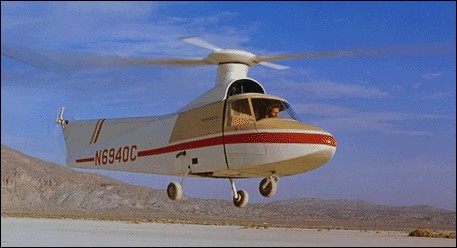
| Lockheed CL-475 1967 |  |
 |

| Lockheed CL-475 1967 |  |
 |
|
Lockheed started a programme of helicopter research in the mid-1950s. The CL-475 (N6940C) was a two-seat machine with a slab-sided tube and fabric fuselage, and fixed tricycle undercarriage equipped with a 140hp Lycoming VO-360-A1A piston engine mounted above and behind the cockpit. It flew on 2 November 1959 and was used to develop a successful rigid rotor concept. It was followed by the Model 186 which was subject of a U.S. Navy research award. R.Simpson "Airlife's Helicopter and Rotorcraft", 1998
A very late comer in the helicopter field - Lockheed's CL-475 prototype flying thirty-five years after Etienne Oemichen had set the first helicopter record (360m in a straight line on 14 April, 1924) confirmed by the Federation Aeronautique Internationale - Lockheed pioneered the now increasingly accepted rigid-rotor concept. Notwithstanding this technical leap, the company was unable to capitalize on its initial success and, after a thirteen-year struggle, bowed out of the field temporarily when the US Army cancelled the development contract for the AH-56A Cheyenne compound helicopter. The concept of the rigid rotor coupled to a gyroscope system was developed by an Advanced Concepts Group led by Irven Culver to seek significant improvements in performance, cost, reliability, and handling characteristics of helicopters. Following testing of a small radio-controlled vehicle - with a 1.52m diameter, two blade, hingeless rotor driven by a McCoy 60 model aeroplane engine - the small design team undertook in July 1959 to design and build an experimental two-seat helicopter for full-scale demonstration of the new concept. Designated CL-475, this research helicopter had a simple structure with steel and aluminium tubing covered with fabric and a Plexiglass cabin with side-by-side seats. Its 140hp Lycoming VO-360-AIA four-cylinder air-cooled engine initially drove a two-blade wooden rotor, with gyroscopic control being provided by a double metal 'lollipop' attached to the blades and connected to the swashplate by springs. In this form the CL-475, which was registered N6940C, was completed in autumn 1959 and was trucked to Rosamond Lake in the Mojave Desert where initial trials could be made without attracting undue attention, as Lockheed still wished to keep its helicopter research programme out of the limelight. Excessive vibration was encountered during the first flight on 2 November, 1959, and forced Irv Culver's team to experiment during the next six months with a variety of three- and four-blade wooden rotor designs. The vibration problem, however, was brought within reasonable limits only after the adoption of a three-blade metal rotor and the installation of a new gyroscopic ring attached directly to the swashplate. The CL-475, which in mid-1960 had been moved to the Lockheed facility at Rye Canyon, was then evaluated by FAA, NASA and military pilots and proved to be easy to fly. In fact, a pilot without previous helicopter experience was once able to ferry it alone. Pleased with the results, Lockheed incorporated the rigid-rotor concept in its entry for the US Army light observation helicopter (LOH) competition in 1961. Although the Army did not select this Lockheed design, it had sufficient confidence in the new concept to order jointly with the Navy two Lockheed XH-51 research helicopters. At the end of its trial programme, the CL-475 was put in storage until 1975, when it was donated by Lockheed to the National Air and Space Museum, Smithsonian Institution. It has now been loaned to the US Army Aviation Museum at Fort Rucker, Alabama. R.Francillon "Lockheed Aircraft Since 1913", 1987
|